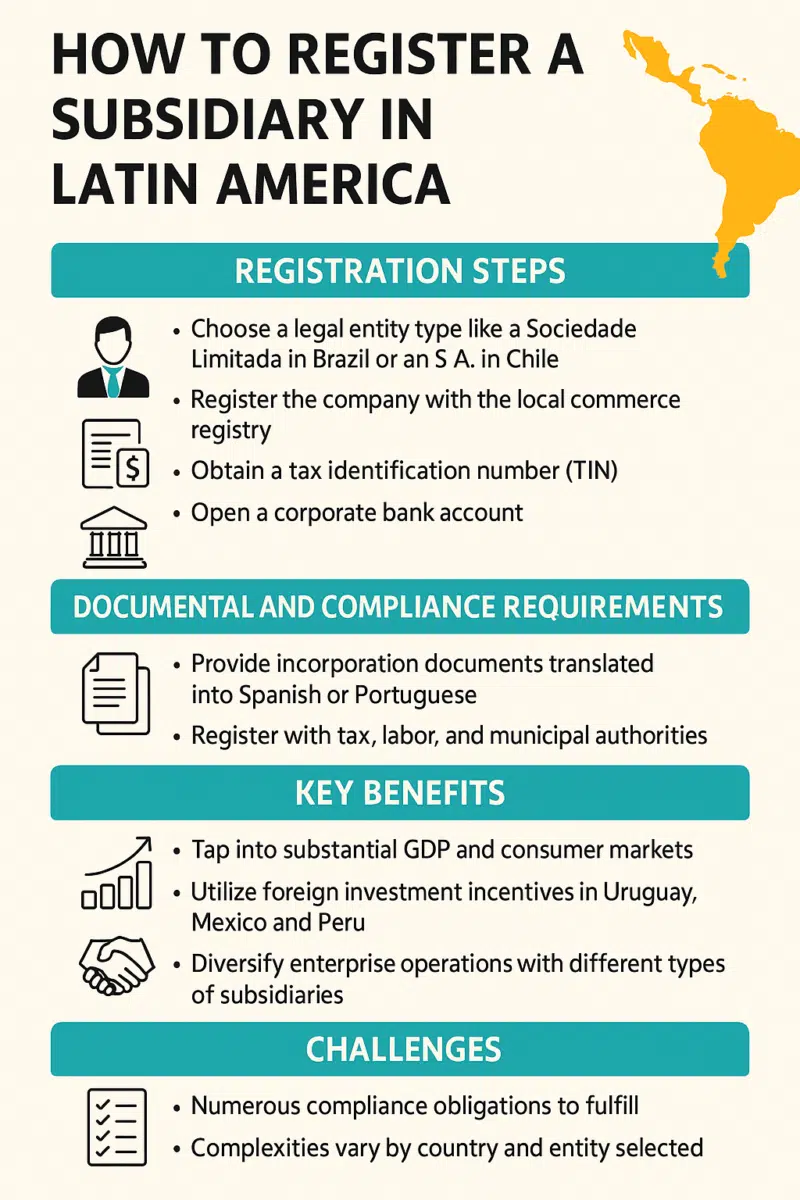Luis Fuentes, a finance specialist and international business expert, serves as Corporate Affairs Director at Alligare International LLC and leads Estudio Fuentes. With over 10 years of experience, he excels in financial advisory, business internationalization, and strategic corporate solutions, helping companies in Latin America, Europe, and Asia expand globally.
- Luis Fuenteshttps://perubizconnect.com/author/perubizconnect/
- Luis Fuenteshttps://perubizconnect.com/author/perubizconnect/
- Luis Fuenteshttps://perubizconnect.com/author/perubizconnect/
- Luis Fuenteshttps://perubizconnect.com/author/perubizconnect/
Register a subsidiary in Latin America with ease. Discover the steps, legal structures, and compliance tips for company incorporation.
Table of Contents
How to Register a Subsidiary in Latin America?
To register a subsidiary in Latin America, the process typically involves registering the company with the local registry of commerce, obtaining a tax identification number, opening a bank account, and complying with additional legal and fiscal obligations. These steps reflect the growing trend toward modernization in the region’s corporate law systems, as analyzed in this comprehensive review of legal developments.
This process is crucial for companies looking to expand their operations in high-potential economies such as Brazil, Colombia, Peru, Uruguay, and Mexico—nations that collectively contribute a significant portion to the region’s gross domestic product (GDP).

What Are the General Steps to Incorporate a Subsidiary?
Incorporating a subsidiary in Latin America requires understanding the legal foundation and local nuances of each country. While procedures can differ, several core steps apply broadly across the region and are essential for establishing a fully compliant and operational business entity. These steps often include preparing necessary documents, selecting the appropriate legal structure, and ensuring alignment with compliance obligations and foreign investment policies.
What Legal Structure Should You Choose?
Selecting the appropriate legal entity, such as a Sociedade Limitada in Brazil or Sociedad Anónima in Chile, determines liability and tax status. A comparative look at these frameworks is available in this Springer chapter on institutional evolution in Latin America.
How Do You File the Articles of Incorporation?
Drafting and submitting incorporation documents formalizes the subsidiary’s legal existence. Their fiscal implications are detailed in this case study on foreign investment taxation. This step is one of the most essential parts of company registration in the region.
Where Do You Register the Company Legally?
Legal recognition depends on proper registration. The strategic role of registries is explained in this article on FDI and corporate strategies.
Why Is Obtaining a Tax Identification Number Essential?
Without a TIN, companies cannot issue invoices or hire staff. This requirement aligns with the principles outlined in this JSTOR article on Latin American tax systems.
How Do You Open a Corporate Bank Account?
Financial institutions demand verified legal documents and tax credentials. The interplay between banking access and compliance is explored in this development economics analysis.
Which Authorities Must You Register With?
This includes labor, pension, and municipal agencies. A broader legal framework is detailed in this legal study on investment laws in the region.
What Country-Specific Requirements Might Apply?
These vary by jurisdiction and may include public notices or capital proof. A structured view of these variations is presented in this Springer chapter on emerging market regulations.
What Are the Key Procedures in Each Country?
Each Latin American country has unique requirements, incentives, and processes for foreign investors. Understanding these distinctions is critical to navigating the legal and regulatory landscapes efficiently and ensuring long-term compliance. For example, the types of subsidiaries allowed in Brazil may differ in form and registration steps compared to Mexico or Uruguay.
What Are the Registration Steps in Brazil?
Brazil requires tax registration, local representation, and interaction with Receita Federal. Its rejection of tax-sparing treaties is analyzed in this study on FDI taxation reforms.
How Do Foreign Subsidiaries Operate in Chile?
Foreign subsidiaries benefit from legal protections and ease of repatriation, discussed in this Springer chapter on Chinese corporate presence.
How Does Colombia Support Foreign Investment?
Free zones and preferential regimes are key. An energy-sector investment case is examined in this article on regional geopolitical influence.
What Makes Peru Attractive for Subsidiaries?
Peru requires notarial registration and offers generous incentives. The fiscal design behind those incentives is broken down in this chapter on corporate tax competition.
What Are the Legal Obligations in the Dominican Republic?
Companies must comply with layered legal requirements and appoint local agents. Regulatory procedures are outlined in this comparative legal survey.
What Are the Most Common Questions About Registering a Subsidiary in Latin America?
Navigating corporate procedures across multiple countries can raise practical questions. Here are some concise answers that address frequent investor concerns.
How long does it take to incorporate a subsidiary in Latin America?
Timelines vary by country but generally range from 4 to 12 weeks, depending on document validation and registration office workload.
Do I need a local partner to open a subsidiary?
In some countries like Brazil or Colombia, local representation is required, though not necessarily a local equity partner.
Can one legal structure be used across all countries?
No. Each country has distinct entity types and legal implications. Customization is necessary based on jurisdiction.
Are there tax incentives for foreign subsidiaries?
Yes. Countries like Peru and Colombia offer tax holidays, free trade zones, and sector-specific incentives to attract FDI.
Is it mandatory to translate incorporation documents?
Yes. Most countries require documents in their official language (Spanish or Portuguese), often with certified translation and apostille.
What Should You Keep in Mind Before Starting the Incorporation Process?
Successfully incorporating a subsidiary in Latin America requires more than understanding the legal steps—it demands careful planning, local expertise, and a strategic approach tailored to the target country. By aligning your goals with jurisdiction-specific requirements and incentives, you can turn the complexities of incorporation into a competitive advantage. Working with established partners like Multiplier can streamline the process, mitigate common challenges, and ensure compliance with all local and international obligations.
You can contact me and Estudio Fuentes if you want to speak with an expert on this topic.
You might be interested in this:
- Register a subsidiary in Peru
- Register a subsidiary in Brazil
- Register a subsidiary in Mexico
- Register a subsidiary in Chile
- Register a subsidiary in Uruguay
- Register a subsidiary in Dominican Republic
PS: You might be interested in the service of COMPANY FORMATION AGENT IN LATIN AMERICA and PERU




